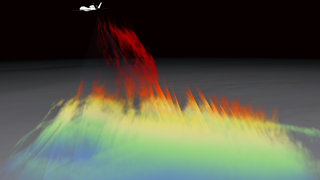Storm Watchers
Satellites revolutionized scientists' ability to study hurricanes, providing valuable insights into what makes a storm tick. But detailed observations are limited to times when a satellite’s orbit crosses a hurricane's path. To combat this issue, NASA is experimenting with putting the same types of instruments that fly on satellites aboard unmanned aerial vehicles. In 2007 NASA acquired two Global Hawk aircraft originally designed for military use. The remote-controlled planes have since been equipped with tools for surveying storms. The planes can fly above a storm for hours on end, allowing scientists to make measurements over long periods of time. The data they collect will improve our understanding of how storms evolve. Watch the video to see how the aircraft's scanning radar system detects hot towers—columns of clouds and rising warm air that power hurricanes.

NASA sends unmanned aircraft to spy on hurricanes.
This visualization shows how NASA’s Global Hawk aircraft scan storms for the presence of hot towers (red).

The signature shape of a hot tower can be seen in this image.

As the aircraft crisscrosses the storm, the locations of more hot towers are revealed.

Hot towers surround the storm's eye, forming the eyewall—the most destructive region of a hurricane.
For More Information
See NASA.gov
Credits
Please give credit for this item to:
NASA's Goddard Space Flight Center
-
Animators
- Lori Perkins (NASA/GSFC)
- Greg Shirah (NASA/GSFC)
- Horace Mitchell (NASA/GSFC)
-
Producer
- Jefferson Beck (USRA)
-
Scientists
- Gerald Heymsfield (NASA/GSFC)
- Stephen R. Guimond (University of Maryland)
- Scott Braun (NASA/GSFC)
- Scott Hanger
-
Project support
- Matthew McLinden (NASA/GSFC)
- Todd W. Powell (Boeing Satellite Systems, Inc.)
-
Writer
- Patrick Lynch (Wyle Information Systems)
Release date
This page was originally published on Tuesday, October 29, 2013.
This page was last updated on Wednesday, May 3, 2023 at 1:51 PM EDT.
